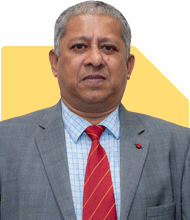Ramalingam Kalirajan |8093 Answers |Ask -Follow
Mutual Funds, Financial Planning Expert - Answered on May 02, 2024
He has an MBA in finance from the University of Madras and is a certified financial planner.
He is the director and chief financial planner at Holistic Investment, a Chennai-based firm that offers financial planning and wealth management advice.... more

I am 38 yrs old with 1lakh salary living in rented house, due to some family issue all my saving gone ,again i hv starting saving from this year through Sip of 1k in each companies ,BOI small cap, nippon india power&infra,quant small,motilal oswal midcap,icici prudential commodities ,icici bluechip ,kotak infra&economics reform,axis nifty IT ,icici pharma index , nippon small cap, quant elss , quant aboslute, bandhan sterling value fund, hdfc focus 30 ,nippon largecap, hdfc multi cap, quant flexi cap , mahindra small cap, prag parikh flexi cap, quant large cap, quant psu fund, sbi balanced advantage , aditya birla sunlife osu equity , sbi energy opportunities fund, ppf 8k. Whether i need to conssolidate or better to invest in all with this amount till 1 yr and then consolidate as i want to retire at the age 55yrs and how much corpus i need for retirement at 55yrs and what amount i need to save ,my monthly expense is 55-60k?? Please help!!
Here are some suggestions:
Consolidate: Consider consolidating your portfolio to a more manageable number of funds, perhaps around 5-10 well-chosen funds. Look for funds that cover different asset classes, investment styles, and market caps to ensure adequate diversification.
Review Performance: Evaluate the performance of each fund in your portfolio regularly. Keep funds that have consistently performed well over the long term and consider replacing underperforming funds with better alternatives.
Risk Assessment: Ensure that your portfolio aligns with your risk tolerance and investment goals. Since you have a specific retirement goal in mind, it's crucial to assess whether your current portfolio allocation will help you achieve that goal.
Asset Allocation: Consider your desired asset allocation based on your risk tolerance and investment horizon. Allocate a portion of your portfolio to equities for long-term growth potential, but also consider fixed income or debt investments for stability and income.
Retirement Planning: Calculate how much you'll need for retirement at age 55 based on your current expenses, expected inflation, and any other sources of retirement income (like PPF). A financial advisor can help you determine an appropriate savings goal and investment strategy to reach that target.
Emergency Fund: Make sure you have an adequate emergency fund to cover unexpected expenses, typically 3-6 months' worth of living expenses.
Seek Professional Advice: Consider consulting with a financial advisor who can provide personalized guidance based on your financial situation, goals, and risk tolerance. They can help you create a comprehensive financial plan tailored to your needs.
By consolidating your portfolio, reviewing your investments regularly, and planning strategically for retirement, you can work towards building a more efficient and effective investment strategy.
You may like to see similar questions and answers below
Ramalingam Kalirajan |8093 Answers |Ask -Follow
Mutual Funds, Financial Planning Expert - Answered on May 08, 2024
Ramalingam Kalirajan |8093 Answers |Ask -Follow
Mutual Funds, Financial Planning Expert - Answered on May 08, 2024
Ramalingam Kalirajan |8093 Answers |Ask -Follow
Mutual Funds, Financial Planning Expert - Answered on May 08, 2024
Ramalingam Kalirajan |8093 Answers |Ask -Follow
Mutual Funds, Financial Planning Expert - Answered on Jun 18, 2024
Prof Suvasish Mukhopadhyay |500 Answers |Ask -Follow
Career Counsellor - Answered on Mar 12, 2025
Milind Vadjikar |1106 Answers |Ask -Follow
Insurance, Stocks, MF, PF Expert - Answered on Mar 12, 2025
Milind Vadjikar |1106 Answers |Ask -Follow
Insurance, Stocks, MF, PF Expert - Answered on Mar 12, 2025
Milind Vadjikar |1106 Answers |Ask -Follow
Insurance, Stocks, MF, PF Expert - Answered on Mar 12, 2025
Milind Vadjikar |1106 Answers |Ask -Follow
Insurance, Stocks, MF, PF Expert - Answered on Mar 12, 2025
Dr Dipankar Dutta |956 Answers |Ask -Follow
Tech Careers and Skill Development Expert - Answered on Mar 12, 2025
Radheshyam Zanwar |1412 Answers |Ask -Follow
MHT-CET, IIT-JEE, NEET-UG Expert - Answered on Mar 12, 2025
Radheshyam Zanwar |1412 Answers |Ask -Follow
MHT-CET, IIT-JEE, NEET-UG Expert - Answered on Mar 12, 2025
T S Khurana |398 Answers |Ask -Follow
Tax Expert - Answered on Mar 12, 2025
T S Khurana |398 Answers |Ask -Follow
Tax Expert - Answered on Mar 12, 2025

























